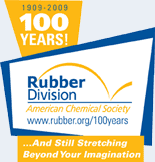![[ Visit ACS Rubber Website ]](images/logo.jpg) |
|
Centennial Elite SponsorsBecome a Centennial Elite Sponsor |
68 A Novel Approach to Rubber-Layered Silicate Nanocomposites PreparationWednesday, October 14, 2009: 10:30 AM
330 (David L. Lawrence Convention Center )
In order to prepare rubber nanocomposites incorporation of nanoclay into the rubber matrix have became a common practice. However, an ideal dispersion of the layered silicate is realized if all the layers are sufficiently separated from one another in the rubber matrix. Unfortunately, the space between two successive layers is usually too small to allow polymer molecules to intercalate into it. To enhance the gap distance between the layers, organic modification is one of the techniques which can be used to overcome that problem. In this method, the cations, present in the gallery for the excess charge counter balancing, are replaced by some quaternary ammonium compound having a long hydrophobic tail. However, organic modification is not a sufficient step to get intercalated and exfoliated structures in the rubber matrix. This means that incorporating such organically modified layered silicates into an amorphous rubber medium does not always result into markedly improved mechanical properties of the rubber vulcanizates. This may be due to the inability to dissociate into individual layers from a substantial portion of layers of packets of the layered material. It also has been attributed, in part, to a lack of affinity between organic polymers and the inorganic layered silicates.
We present a novel approach utilizing stearic acid for the preparation of several rubber nanocomposites. Premixing with the organoclay, the stearic acid serves to swell the clay layers, allowing the rubber molecules to be intercalated into the gallery of layered silicate. Different diene rubbers are used in our study, varying in diene content, molecular structure, and polarity. Many of these diene rubbers, as for example, natural rubber (NR) do not yield a nanocomposite structure by simple melt mixing of the clay and polymer. Although some polymers are capable of partial intercalation or exfoliation with usual dose of stearic acid (2 phr), addition of 10 phr of this additive results in either complete intercalation/exfoliation or an increased percentage of nanocomposite formation, in comparison to the normal rubber-clay composites prepared by melt mixing way. The evidence of a nanocomposite structure is provided by X-ray diffraction patterns, dynamic mechanical analysis, TEM and physical properties. The formulation and the method have been applied to a truck tire tread model compound and the results were compared with a standard reference truck tire tread compound. Finally, it was observed that at least approximately 30 - 40 % reduction in carbon black loading in this formulation without sacrificing the other physical properties like tensile strength, modulus, hardness, rebound resilience etc. could be obtained. Additionally, the beneficial nano-effects of this formulation are reflected in reducing the rolling resistance (as reflected by reduced corresponding tan delta values) of a compound prepared with above mentioned way. However, in order to implement this formulation in real truck tires such properties like abrasion, fatigued to failure, tear resistance etc. will be key issues for the further studies.
|









